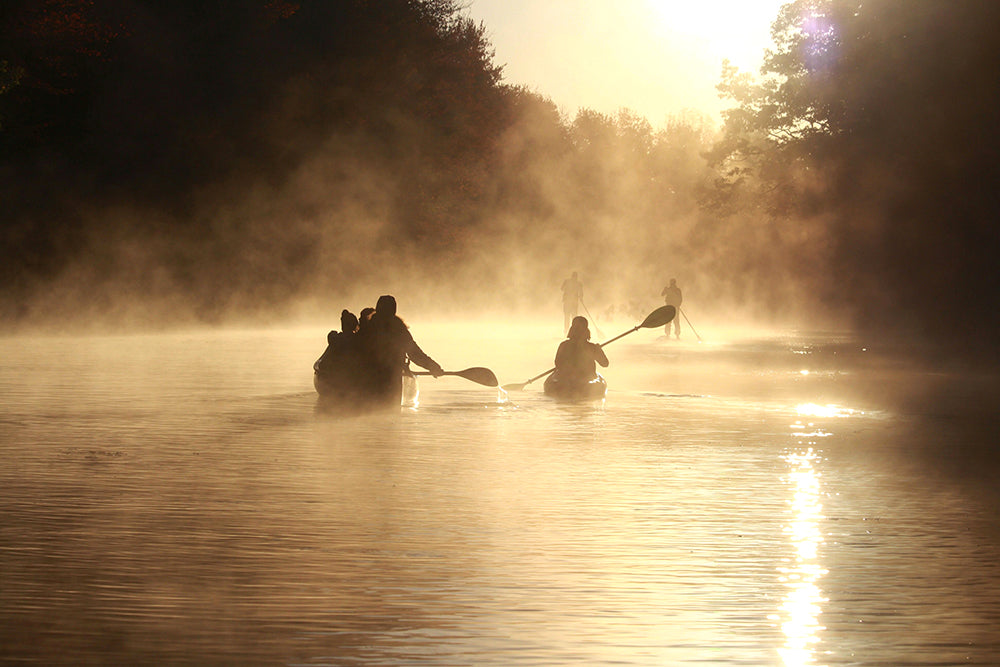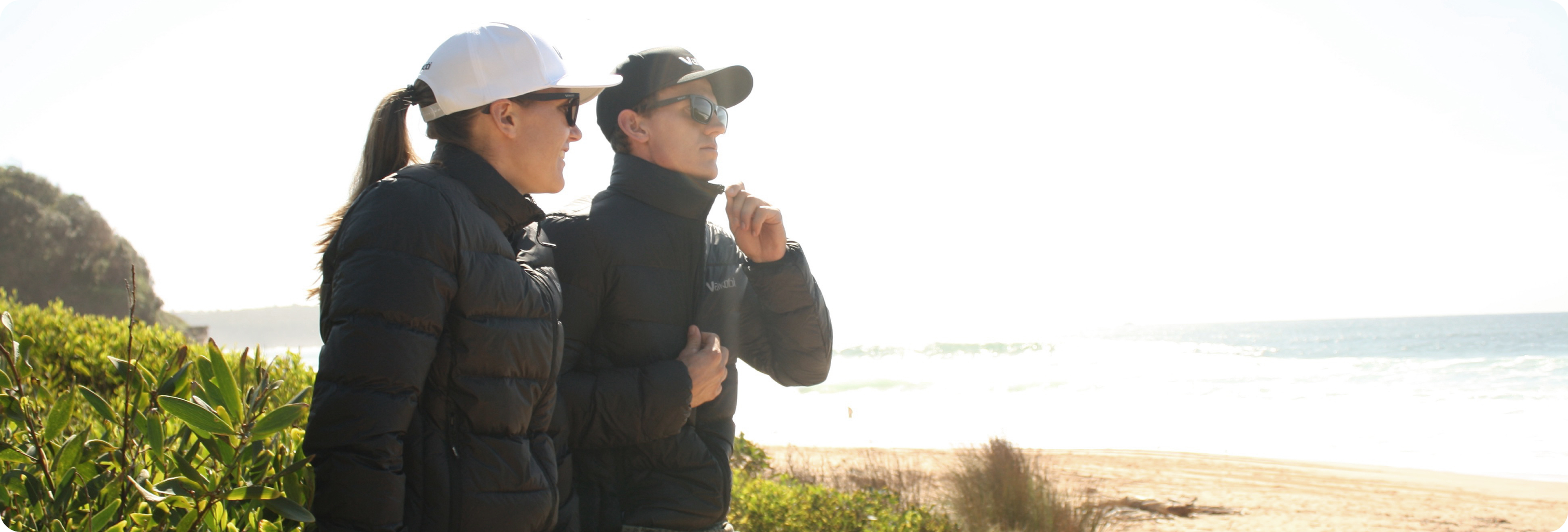Paddling is an awesome way to immerse yourself in the beauty of nature, and way more fun than using a gym to stay fit. So if you’re interested in paddle sports, but not sure on how or where to start, check out this article that explains the key differences between kayaking and canoeing. We’ve got you covered with all the info you need on how to choose and prepare your next experience on the water, in a safe and fun way.
Is canoeing the same as kayaking?
Kayaking and canoeing are both watersports consisting of paddling in small boats, but are quite different. The main difference is the type of the boat you’ll be using, kayak being a closed deck boat, while the canoe is an open deck design. This means that your body’s position and the type of the paddle you’ll use are different for each. In kayaking, the paddler sits inside in a low seat with the legs stretched out, using a double-bladed, light weight paddle. Canoers use a shorter, one-bladed paddle, switching sides to determine the direction, in a seated or kneeling position. The kayak is lower, so you’ll be closer to the water, but very well sealed through the closed deck, so chances to get water inside are small. The deck of a canoe is less protected from the elements, but that’s why the boat has high sides to prevent most water from getting in.
Ultimately, each of these sports brings you a different experience in the water: if you are looking to go further on your adventure, choose kayaking because it is way faster and can be used in more types of water than canoeing. Kayaks are super responsive, allowing you to move forward and backward in the water. So, you'll be able to use it for sightseeing, visiting waterfalls or to have some fun in white water rapids. Keep in mind, though, that the risk of capsizing is higher with the kayak, so make sure you are confident taking it on and off and exiting your kayak before, so that you know how to deal safely in this situation, and always wear a kayaking life jacket.
On the other hand, if you’re into comfort and just want to cruise along slow-moving water like lakes or canals, or want to throw the whole family on board, a canoe is probably the best option for you. It is more stable and spacious, but it will be slower and tougher to turn than the kayak, because it’s built for stability. Again, a good quality canoeing life jacket or PFD, and comfortable water shoes are advised.
Before we paddle further into the practical side of paddling, here are some interesting facts about canoeing and kayaking:
What is canoeing?
The canoe is a lightweight, open deck water vessel, initially made by carving out a single piece of wood, propelled by a seated or kneeling paddler
- The first canoe, discovered in the Netherlands, dating back 10.000 BC, is the oldest known boat in the world. It was dug out with an ax from a scotch pine log.
- The indigenous people of America, the Amazon basin and Polynesia are well known for their canoes, using it as a form of long distance transportation.
- The canoe it’s been an important part in Canadian history, being a symbol of their identity
- There are different types of canoeing: expedition, wilderness tripping, river, recreational, whitewater (with a special type of canoe designed for rapids), racing, fishing and freighter (cargo canoe, having a large load capacity)
- Canoeing covers all the range, from amateur to Olympic Games level (first included in the Olympics in 1936)
What is kayaking?
A kayak is a small closed deck watercraft propelled by a seated paddler, using a double-bladed paddle
- The word kayak originates from the Greenlandic word qajaq
- Kayaks originated in Alaska, Canada and Greenland, being used by the Inuit tribes for hunting
- Scandinavian explorers popularized kayaking in Europe
- Here are the main types of kayaking: recreational, sea kayaking (or touring), whitewater kayaking, kayak surfing, kayak fishing
- Kayaking covers all the range from amateur to Olympic Games level (first included in the Olympics in 1936)
FAQs:
HOW CAN I START KAYAKING OR CANOEING?
The easiest way to try these sports is to book a session or a tour with a guide. This way you’ll be provided with all the equipment you need and also the basics on how to enjoy it safely.
Both sports are beginner friendly, you just need to get familiar with the basic paddling techniques. Balance and core strength are also required, so, to keep things simple, make sure you’ll have your first paddling sessions on calm, flat waters.
IS IT EASIER TO KAYAK OR CANOE?
If you have proper paddling technique, you may find that the kayak is easier to handle, since it is more agile and responsive, while the canoe is slower and more difficult to turn. On the other hand, for kayaking you need to master the skills of keeping the boat upright and avoid capsizing when conditions become tough. In case your kayak flips over, you also need to be prepared to flip it back on the water or to exit safely and swim at shore if possible.
WHERE TO GO CANOEING AND KAYAKING?
You can go canoeing or kayaking anywhere there is water: lake, river, canal, sea or ocean. And usually, in these spots it’s easy to find an outdoor center to book lessons or to rent the equipment. But just in case you are dreaming about an epic paddling adventure, here are top world destinations for each sport. Get inspired!
Top kayaking destinations:
- Sea of Cortez, Baja Peninsula, Mexico
- Northern Vancouver Island, Canada
- Dalmatian Coast, Croatia
- Na Pali Coast, Hawaii, United States
- Haida Gwaii, Canada
- Norway’s Fjords
- Antarctic Peninsula, Antarctica
- Kenai Fjords, Alaska, United States
- Galapagos National Park, Ecuador
- East Coast, Greenland
- Corsica, France
- Fiordland, New Zealand
- Ningaloo Reef, Australia
- The Soca River, Slovenia
- Patagonia, Chile
- Amazon River (passing through Peru, Ecuador, Colombia, Venezuela, Bolivia, Brasil)
- Raja Ampat, Indonesia
Top canoeing destinations:
- Bowron Lakes, British Columbia, Canada
- Everglades National Park, Florida, United States
- Okefenokee National Wildlife Refuge, Georgia, United States
- Belize Barrier Reef, Belize
- The Amazon, South America
- Boundary Waters Canoe Area, Minnesota, United States
- Okavango Delta, Botswana
- Mekong River, Southeast Asia
- Vava’U Islands, Tonga
- Kerala, India
WHAT DO I NEED TO ENJOY EACH SPORT SAFELY?
The success of any water expedition lies in how well you prepare it. Make sure you have the right gear to keep you protected from the elements, safe and comfortable. To make it simple for you, here is a checklist of essentials for kayaking or canoeing.
What you need for a kayaking adventure:
-
A kayak
-
Kayaking paddle
-
Calf Leash
-
Helmet if you plan to explore the water rapids
-
Smock jacket for rough water
-
Life Jacket
-
Long Sleeve UV Treated Rushie
-
UV Paddle Shorts or UV Pants and Leggings
-
Water Shoes
For a canoeing experience, you’ll need:
-
A canoe
-
canoe paddle
-
Life Jacket
-
Long Sleeve UV Rashie
-
UV Paddle Shorts or UV Pants and Leggings
-
Water Shoes
-
Waterproof phone case
When booking a session or a tour, ask the guide what the safety equipment is provided. Apart from the canoe or kayak and paddles, of course, they usually provide you with the helmets and life jackets. For the rest of your checklist, you can’t go wrong with Vaikobi technical gear, designed by paddlers for paddlers. Vaikobi, top quality watersports provider, is here to support you in all your paddling adventures.
Now that you are ready to explore the world by paddling, have fun on the water and enjoy the ride!
(Photo by Kristel Hayes on Unsplash )

